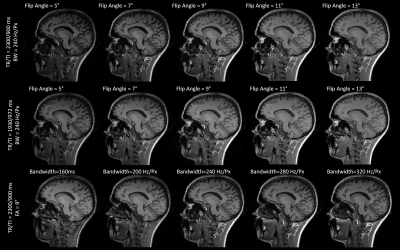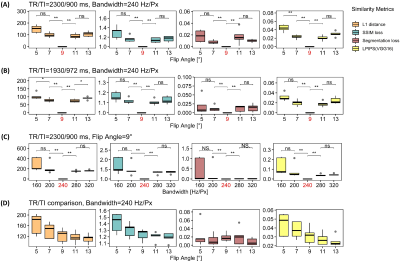Veronica Ravano1,2,3, Gian Franco Piredda1,2,3, Tom Hilbert1,2,3, Bénédicte Maréchal1,2,3, Reto Meuli2, Jean-Philippe Thiran2,3, Tobias Kober1,2,3, and Jonas Richiardi2
1Advanced Clinical Imaging Technology, Siemens Healthineers, Lausanne, Switzerland, 2Department of Radiology, Lausanne University Hospital and University of Lausanne, Lausanne, Switzerland, 3LTS5, Ecole Polytechnique Fédérale de Lausanne, Lausanne, Switzerland
1Advanced Clinical Imaging Technology, Siemens Healthineers, Lausanne, Switzerland, 2Department of Radiology, Lausanne University Hospital and University of Lausanne, Lausanne, Switzerland, 3LTS5, Ecole Polytechnique Fédérale de Lausanne, Lausanne, Switzerland
Perceptual loss is
correlated with L1 distance and outperforms other metrics in detecting changes
in acquisition parameters. Segmentation loss is poorly correlated with other
metrics, suggesting that maximizing these similarity metrics is not sufficient to
harmonize data.

Figure 1. Contrasts obtained from
fourteen different MPRAGE protocols in one example subject. Five equally spaced
flip angles were investigated (between 5° and 13°) for two different
combinations of repetition and inversion times (TR/TI = 2300/900 ms and
1930/972 ms). Five equally spaced read-out bandwidths were also
investigated (between 160 and 320 Hz/Px) for TR/TI=2300/900 ms.

Figure 2. Variation of
similarity losses in four experimental scenarios shown in Table 2. SSIM loss is
defined as the inverse of SSIM. Segmentation loss is defined as the relative
absolute error in the thalamus volume estimation. LPIPS(VGG16) represents a learned
similarity metric based on a perceptual loss. Highlighted x-axis ticks
indicate the corresponding reference image. *: p < 0.05, **: p < 0.01,
***: p < 0.001
